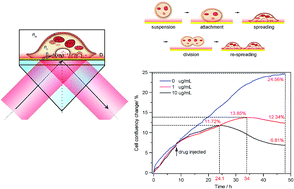An irregular-shaped homogeneous refractive index model for interpretation of the surface plasmon resonance response from living cell attachment†
Abstract
Surface plasmon resonance (SPR)-based biosensors have recently been applied for cell detection. For quantitative interpretation of the SPR response from cell activities, an irregular-shaped homogeneous refractive index model was established. A simple but quantitative mathematical formalism was derived from the model for interpretation of the SPR response from living cell attachment. To validate the mathematical formalism, both SPR and microscopic imaging were used to monitor the dynamic attachment process of HeLa cells to the substrate for >48 h. The interpretation of the SPR response agreed with the cellular morphology changes observed by microscopy, demonstrating the validity of the theoretical SPR model. The SPR response further revealed that the dynamic attachment process of HeLa cells consisted of two phases: a spreading phase and a proliferation phase, with a negative-exponential confluency change of 5.28% and 24.56%, respectively. Additionally, quantitative SPR was applied for the detection of anticancer drug action kinetics. The dynamic attachment process of HeLa cells was monitored on treatment with different concentrations of Paclitaxel for >48 h. We observed distinct cellular attachment kinetics, revealing dose-dependent inhibition of HeLa cell proliferation by Paclitaxel.


 Please wait while we load your content...
Please wait while we load your content...